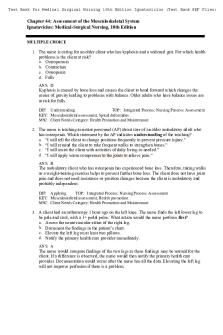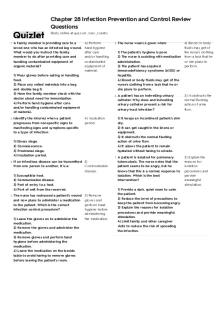Quizlet Chapter 44 PDF

| Title | Quizlet Chapter 44 |
|---|---|
| Course | Pathophysiology |
| Institution | West Coast University |
| Pages | 2 |
| File Size | 60.7 KB |
| File Type | |
| Total Downloads | 85 |
| Total Views | 181 |
Summary
Professor Ali Baroon
Pathophysiology WCU
Quizlet Chapter 44...
Description
Quizlet Chapter 44 The physiologic change most likely to lead to an increase in intracranial pressure is Cerebral vasodilation Manifestations of acute brain ischemia (Cushing reflex) are due primarily to Sympathetic Nervous System Activation Which of the following groups of clinical findings indicates the poorest neurologic functioning? Assumes decorticate posture w/ light touch, no verbal response Acceleration-deceleration movements of the head often result in polar injuries in which Focal injuries occur in two places at opposite poles Diffuse injuries occur When movement of the brain causes widespread neuronal damage Decorticating posturing Is an abnormal flexor response of the arms & wrists, with legs and feet extended & internally rotated Secondary injury after head trauma refers to Brain injury due to the body’s response to tissue damage Hyperventilation is indicated in the management of An acute elevation of intracranial pressure Appropriate treatment for head trauma Head elevation Free water restriction Bed rest Hyperventilation Risk factors for hemorrhagic stroke include Acute hypertension Cardiac disease complicated by arterial fibrillation is An important risk factor for emboli strokes The stroke etiology w/ the highest morbidity & mortality is Intracranial hemorrhage
Ischemic strokes are the most common & include Thrombotic and embolic types Clinical manifestations of a stroke within the right cerebral hemisphere include Left sided muscle weakness & neglect Aphasia is an integrative language disorder That occurs w/ brain damage to the dominant cerebral hemisphere (usually left) & involves all language modalities In the acute phase of stroke, treatment is focused on Stabilization of respiratory & cardiovascular function Embolic stroke is usually From a cardiac source Subdural hematomas are related To trauma Subarachnoid hemorrhage is more commonly Associated with rupture of cerebral aneurysms Leakage of CSF from the nose or ears is commonly associated with Basilar skull fracture Fracture of the temporal bone commonly results In an acute epidural hemorrhage Rupture of a cerebral aneurysm should be suspected if the patient reports Sudden, severe headache Subarachnoid hemorrhage is usually managed w/ volume expansion & blood pressure support to enhance cerebral perfusion. This is necessary because subarachnoid hemorrhage predisposes to Cerebral vasospasm/hydrocephalus Vasospasm is managed by Keeping blood volume and blood pressure @ normal to high levels Meningitis is characterized by Headache Fever Stiff neck
Signs of confusion Encephalitis is Inflammation of the brain usually caused by a virus It is true that epidural bleeding is Characterized by a lucid interval immediately after injury The most important determinant for prescribing therapy for acute stroke is Ischemic versus hemorrhagic cause Intracranial pressure normally ranges from 0-15mmHg Cytotoxic edema occurs When ischemic tissue swells because of cellular energy failure A severe complication of elevated intracranial pressure is Brain herniation Interstitial edema Is usually secondary to increased capillary endothelium from chemical injury, or sudden increase in vascular pressure beyond autoregulatory limits Vasogenic edema Is a consequence of stroke, ischemia, and severe hypertension, and may occur surrounding brain tumors A tool used to assess levels of consciousness is Glasgow Coma Scale The first indication of brain compression from increasing intracranial pressure may be Sluggish pupil response to light A level of 3 on the Glasgow Coma Scale Indicates likely fatal damage A GCS level of 15 is Considered normal A GCS level of 12 or higher Indicates mild damage A GCS level of 8 Indicates severe damage Nystagmus is
A persistent rhythmic or jerky movement in one both eyes Dysconjugate movements occur When the eyes do not move together in the same direction The doll’s eye test is performed By holding open the patients’ eyelids & rotating the head from one side to the other. If the brainstem is intact, the eyes will turn in direction opposite to the direction of the head rotation Which brain disorders are a cause of acute brain injury? Brain trauma Brain hemorrhage CNS infections...
Similar Free PDFs

Quizlet Chapter 44
- 2 Pages

Chapter 44 notes
- 5 Pages

Chapter 44 - Practice questions
- 14 Pages

Chapter 44 - Legal Accountability
- 13 Pages

Chapter 44 - operating segments
- 17 Pages

Module 44 - Lecture notes 44
- 3 Pages

Page 44
- 1 Pages

Chapter 9 - quizlet
- 3 Pages

Quizlet chapter 8
- 37 Pages

Chapter 16 Flashcards Quizlet
- 4 Pages

Quizlet chapter 19 implementing
- 3 Pages

Chapter 7 Flashcards Quizlet
- 8 Pages

Quizlet chapter 28 infection
- 2 Pages

Chapter 8 Flashcards Quizlet
- 11 Pages
Popular Institutions
- Tinajero National High School - Annex
- Politeknik Caltex Riau
- Yokohama City University
- SGT University
- University of Al-Qadisiyah
- Divine Word College of Vigan
- Techniek College Rotterdam
- Universidade de Santiago
- Universiti Teknologi MARA Cawangan Johor Kampus Pasir Gudang
- Poltekkes Kemenkes Yogyakarta
- Baguio City National High School
- Colegio san marcos
- preparatoria uno
- Centro de Bachillerato Tecnológico Industrial y de Servicios No. 107
- Dalian Maritime University
- Quang Trung Secondary School
- Colegio Tecnológico en Informática
- Corporación Regional de Educación Superior
- Grupo CEDVA
- Dar Al Uloom University
- Centro de Estudios Preuniversitarios de la Universidad Nacional de Ingeniería
- 上智大学
- Aakash International School, Nuna Majara
- San Felipe Neri Catholic School
- Kang Chiao International School - New Taipei City
- Misamis Occidental National High School
- Institución Educativa Escuela Normal Juan Ladrilleros
- Kolehiyo ng Pantukan
- Batanes State College
- Instituto Continental
- Sekolah Menengah Kejuruan Kesehatan Kaltara (Tarakan)
- Colegio de La Inmaculada Concepcion - Cebu

